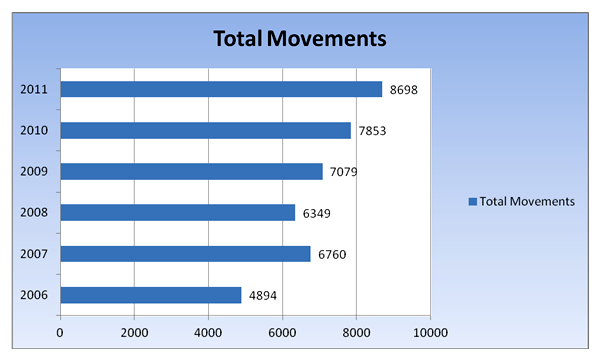IRAQ. Erbil International Airport (EIA) posted a +37% increase in passenger numbers to 621,870 in 2011 – the strongest year-on-year growth for the airport in five years. The average passenger growth rate since 2006 and the launch of civilian aviation traffic at EIA is +31.5% a year.
Following the liberation of Iraq in 2003, the Kurdistan Regional Government (KRG) decided to transform Erbil’s former military base into a modern civil aviation airport to serve as a major gateway to the world.
Erbil International Airport (EIA) officially opened on 7 July 2005 and it welcomed its first IATA carrier on 11 December the following year. The KRG’s fifth cabinet and its then Prime Minister, Nichevan Barzani, later commissioned the building of a new and modern airport, which opened in 2010 at a cost of US$550 million.
 |
The strong annual performance puts the airport four years ahead of its own master plan, which had predicted 430,000 passengers in 2011. The increase in passenger numbers will help cement the new airport as one of the fastest growing aviation hubs in the Middle East, EIA said.
With an average of 11 flights a day, the airport is set to grow further in 2012 – but at an anticipated slower rate reflecting the onset of a period of consolidation for EIA the state of the economy.
EIA attributes the strong growth to new routes and increased frequencies from existing carriers. New routes in 2011 have included Turkish Airways to Istanbul, Pegasus to Ankara, Eygpt Air to Cairo, and Air Cyprus to Larnaca. Etihad increased its frequency from twice to four times per week.
 |
Total traffic movement is a combination of passenger and cargo air traffic movements arriving and departing EIA and reflects the growth of the airport; the decrease in 2008 reflects fewer cargo flights in that year, EIA says |
The most popular routes remain Istanbul and Baghdad, with Turkish Airlines and AtlasJet leading the way on routes to the north. Iraqi Airways continues to operate the most flights into Erbil with an average of around 95 a month.
EIA said that the monthly pattern for travel demand through the airport is consistent with other airports in the Middle East and sees peak traffic through in July and September.
 |
Commenting on the record growth, EIA Airport Director Talar Faiq said: “In March ahead of the official opening I told the media we anticipated around 600,000 passengers this year – that we have exceeded that total, and processed more than 621,000 passengers is welcome news and a great endorsement of the airport in its first official year of operation.
 |
“I expect the coming year to be one of consolidation with fewer new airlines arriving, but existing airlines developing their business “ |
Talar Faiq Airport Director Erbil International Airport |
“The growth in passenger numbers reflects not only the confidence the airlines have placed in operations at EIA but also the hard work of all the agencies involved – immigration, customs and security at EIA’s own team. It is also a direct reflection on what is happening in Kurdistan – the growing economy, the security and stability overseen by the KRG, and the growing reputation of Kurdistan as a place to visit and do business.
“It has been a year of firsts for EIA – not only in the official opening but also in behind-the-scenes developments that are so vital to the running of an airport to international standards – from the airport certification via the Iraqi Civil Aviation Authority, to the ability for EIA to control airspace around the airport, to the implementation of safety procedures to the opening up of a business lounge. EIA has invested a great deal in training for radar and air traffic control, to developing is operational staff and ensuring they have the skills to do their jobs. Such developments and milestones are essential to the airports future development.
“The new airport started operating in September 2010, and was officially opened by the KRG President Masood Barzani and Prime Minister Erdoggan of Turkey in March. I expect the coming year to be one of consolidation with fewer new airlines arriving, but existing airlines developing their business. I anticipate further growth in cargo as Kurdistan’s growth fuels a demand for imports and the ending of exclusive cargo deals opens up the market to more carriers.
“The master plan is a document mapping out the next 30 years for EIA – that we are ahead of schedule is great news but we must think long term and ensure steps are taken to put in place the expertise and infrastructure to take EIA to the next level.
“To do so is not an end in itself, but serves to reinforce the role of the airport as a gateway to Kurdistan and a vital economic enabler for development yet to come.”
Advertisement | |





